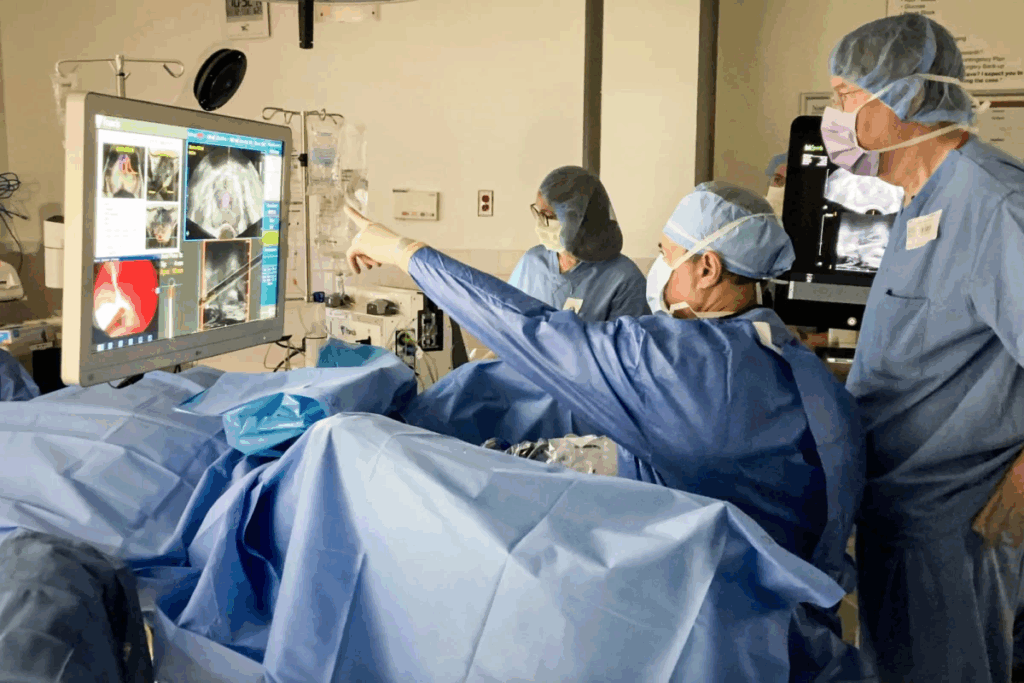Last Updated on November 24, 2025 by

Having tumor resection surgery can be scary. Knowing what to expect is key for patients. The time it takes varies a lot. This depends on where the tumor is, its type, and how complex it is.
We focus on giving our patients the best care and advice. The time for a tumor resection surgery can change a lot. It’s important to know these factors to improve patient care and chances of survival.
A TURBT procedure for bladder surgery might take different times than other tumor resections. We will look at how long surgeries for different cancers usually take. We’ll also see how new techniques can help.
Several key factors determine how long a tumor resection procedure will take. Understanding these factors helps us prepare and tailor our approach to each patient’s unique needs.
The location of the tumor plays a significant role in determining the surgery duration. Tumors in more accessible locations can typically be resected more quickly. For instance, in bladder cancer surgery, the accessibility of the tumor within the bladder can significantly impact the duration of the transurethral resection of bladder tumor (TURBT) procedure.
We consider the anatomy of the patient and the specific location of the tumor to plan the most efficient surgical approach. Tumors that are harder to reach may require more time and complex techniques.
The size and complexity of the tumor are also key factors. Larger and more complex tumors require longer surgery times due to the need for more meticulous dissection and removal. In cases involving TURBT, the size of the tumor can influence whether additional treatments, such as fulguration, are necessary.
Our surgical team assesses the tumor’s characteristics pre-operatively to anticipate any challenges and plan.
Patient-specific factors, including overall health, previous surgeries, and specific medical conditions, can also influence the duration of tumor resection. For example, patients with a history of previous surgeries in the same area may require more time due to the presence of scar tissue.
We take these factors into account to ensure that our surgical plan is tailored to the individual needs of each patient, optimizing both the duration and the outcome of the surgery.
The following are key considerations that impact tumor resection duration:
By carefully evaluating these factors, we can better estimate the duration of the surgery and prepare for any challenges that may arise, ensuring the best possible outcome for our patients.
Knowing how long a TURBT procedure takes can ease worries for bladder cancer patients. The Transurethral Resection of Bladder Tumor (TURBT) is a key surgery for diagnosing and treating bladder cancer.
The time it takes for a TURBT procedure can change based on several things. Usually, it’s a quick surgery. But the exact time can depend on the tumor’s details and the patient’s health.
A typical TURBT for bladder cancer lasts from 30 minutes to 1 hour. But, this time it can change based on the case’s complexity.
Several factors can affect the procedure’s length:
Several things can make a TURBT procedure longer. These include:

Fulguration, which uses electric current to destroy tumor tissue, is often done during TURBT. This extra treatment can make the surgery longer.
Our medical team is skilled in performing TURBT procedures with care and precision. We aim to give patients the best results.
We use the latest technology and team up with different specialists. This way, we can make the TURBT procedure fit each patient’s needs. We focus on making the treatment both effective and efficient.
Knowing how long different tumor resections take is key to setting patient expectations. These surgeries vary in complexity and challenge.
We are experts in many types of tumor resections. The time each surgery takes can differ a lot.
Colorectal tumor surgeries usually last 2 to 4 hours. The time needed depends on the tumor’s size, where it is, and how complex the surgery is. Our surgeons use the latest methods to get the best results.
Brain tumor surgeries are very complex. They can last 2 to 8 hours or more. This depends on where the tumor is and how detailed the surgery is. Our team uses the latest technology for these precise procedures.
Cardiac tumor surgeries usually last 3 to 6 hours. The time needed depends on the tumor’s size and how it affects the heart. Our cardiac surgeons work with a team to get the best results.
While TURBT is common for bladder cancer, more complex surgeries like radical cystectomy might be needed for advanced cases. These surgeries can vary in length. Our urologists will guide and care for each patient personally.
At our institution, we can handle many types of tumor resection surgeries. We use advanced techniques to improve outcomes and support our patients through their treatment.
Advanced techniques are changing how we do tumour resection surgeries. They are making these operations shorter. At our institution, we use these new methods to give our patients the best care.
Minimally invasive surgery is changing tumour resection. Laparoscopic and robotic surgery have many benefits. They include less recovery time, less pain, and smaller cuts.
In transurethral bladder procedures, these methods make surgery shorter and better for patients.
Compared to open surgery, these methods mean shorter hospital stays and faster recovery. But the choice depends on the tumor’s location and size and the patient’s health.
Technology is key to taking tumor resection surgery. New imaging, like intraoperative MR, helps find and remove tumors more accurately. Advanced tools and equipment, like robotic systems, help us do complex surgeries with more precision.
These technologies not only make surgeries shorter but also improve results. For example, advanced imaging helps avoid harming nearby important structures. A study on Dovepress shows how important these advancements are for complex cases.
For complex tumor resections, a team approach is key. Our team includes surgeons, radiologists, pathologists, and more. We work together to create a treatment plan that fits each patient’s needs.
This teamwork ensures we consider all parts of the patient’s condition. It leads to more effective and efficient surgeries. For example, in bladder mass removal, a team can give a more accurate diagnosis and treatment plan. This improves patient outcomes.
The time it takes for tumor resection surgery greatly affects how well a patient recovers and their overall health. At LivHospital, we’ve seen that shorter surgeries lead to better recovery, lower costs, and higher survival rates. This is very important for patients with bladder cancer, as the surgery time can change based on several factors.
We use the latest techniques and protocols to make surgeries shorter and better for patients. Our goal is to provide top-notch healthcare and support to patients from around the world. By understanding what affects surgery time and using new medical technology, we aim to improve patient care.
A Transurethral Resection of Bladder Tumor (TURBT) procedure is usually quick. The time it takes depends on the size and number of tumors.
Several things can change how long tumor resection surgery takes. These include where the tumor is, how big it is, and how complex it is. Also, the patient’s health and past surgeries play a role.
Bladder cancer operations, like TURBT, vary in length. TURBT is quick. But other operations can take longer, depending on the disease’s complexity and extent.
Fulguration is a method used in TURBT. It uses an electric current to kill tumor tissue. This can make the procedure longer.
Yes, different tumor resections have different times. For example, colorectal tumor resections take 2 to 4 hours. Brain tumor resections can take 2 to 8 hours or more, based on complexity.
New techniques like minimally invasive surgery make operations shorter. This leads to better results for patients.
Shorter surgeries mean fewer complications and lower costs. They also lead to better survival rates. This shows why making surgeries shorter is key.
A team of specialists ensures complex tumour resections are done carefully. This approach helps improve patient outcomes.
Subscribe to our e-newsletter to stay informed about the latest innovations in the world of health and exclusive offers!